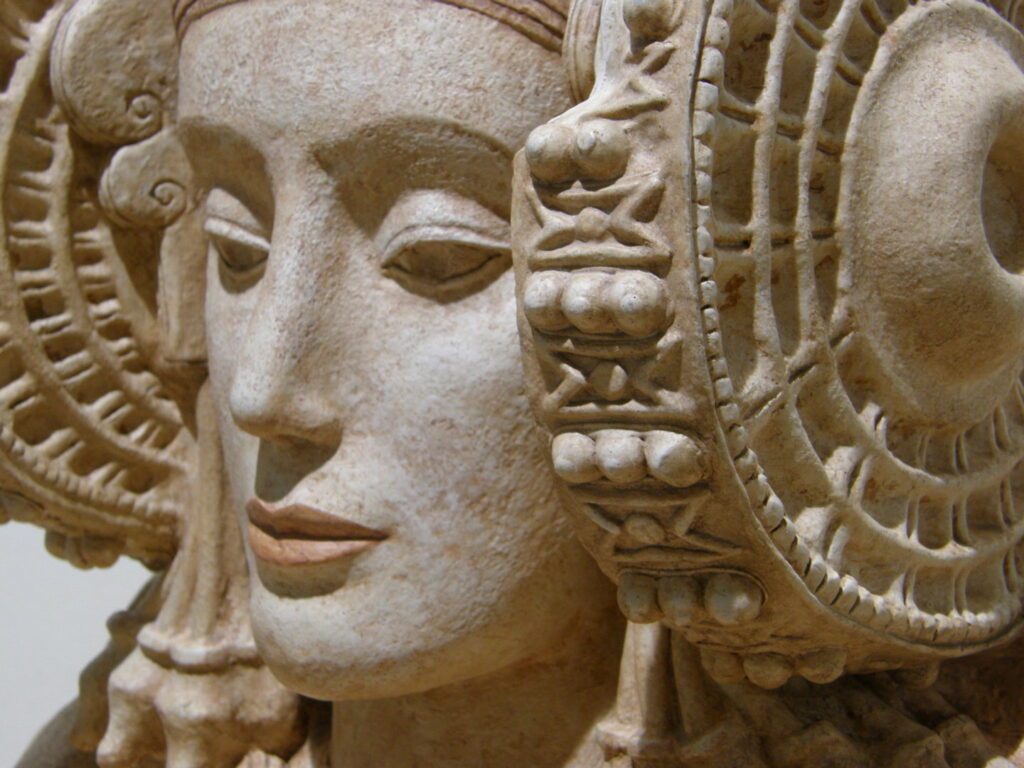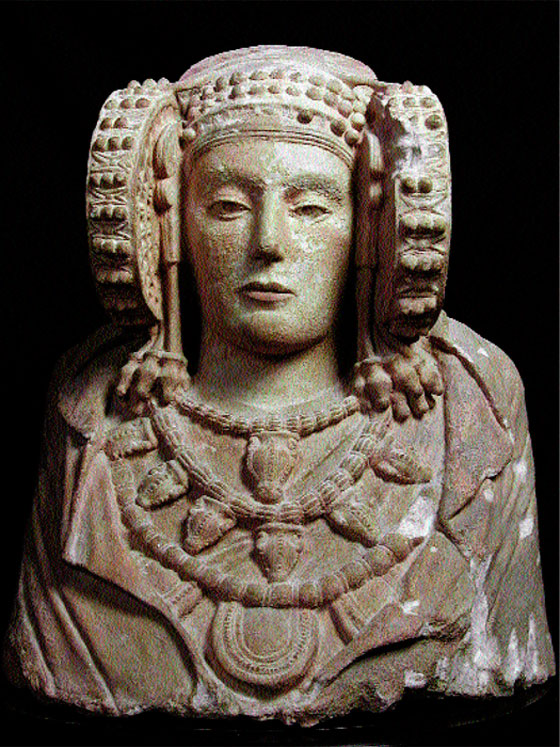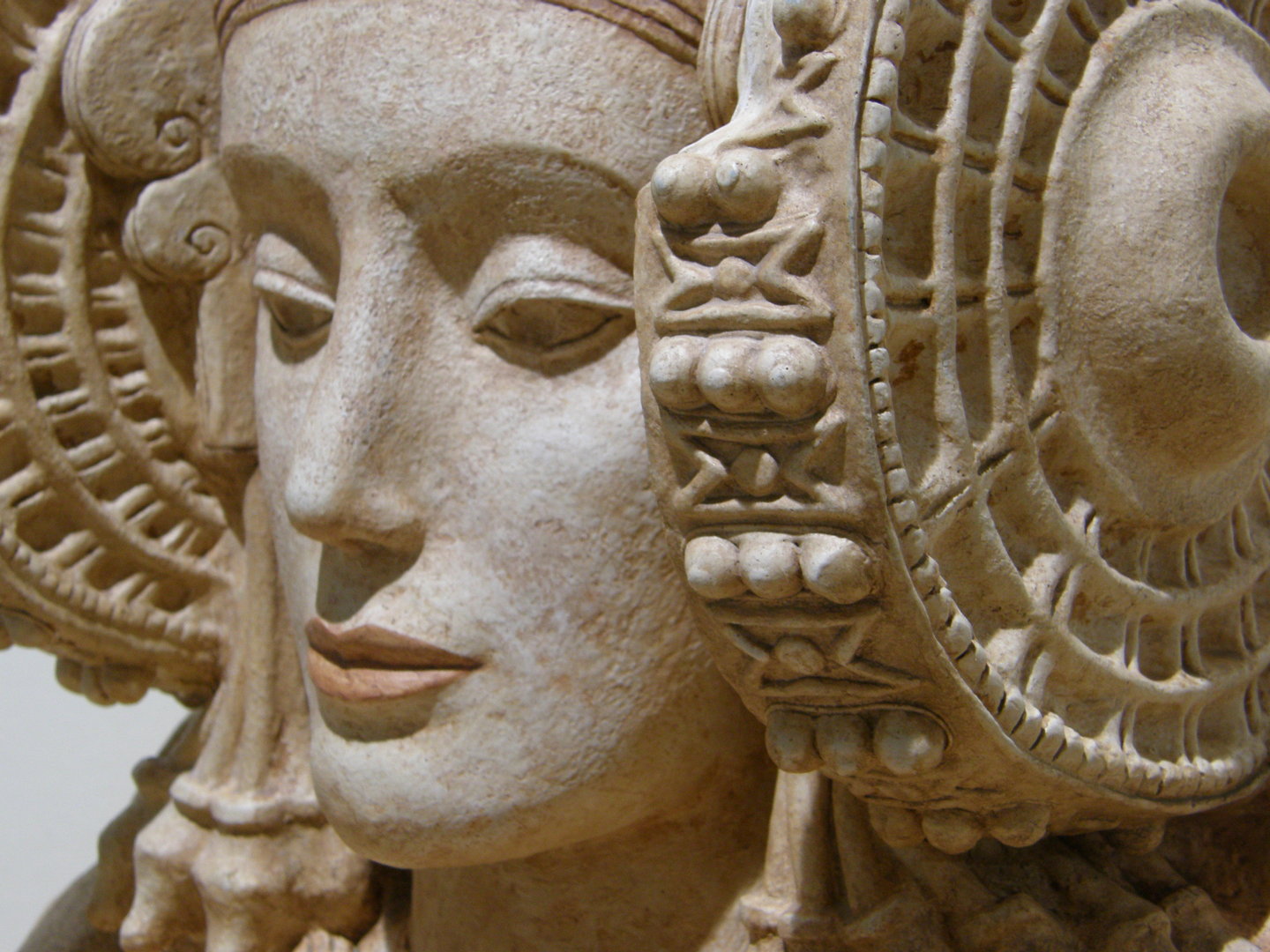I first encountered the famed busto in photographs, and it quickly became an obsession that mixed art and archaeology for me. Found on August 4, 1897 at La Alcudia near Elche, this Iberian escultura measures 56 cm by 45 cm by 37 cm and weighs 65.08 kg.
What drew me in was the rich polychromy traces in red, white, and blue and the intricate iconography: a tiara, side rodetes, ínfulas, layered garments, a fíbula, and three necklaces with amulets. A 16 cm deep cavity hints at ritual or funerary use.
Scholars date the piece to siglo V–IV BCE and place its current care in the museo arqueológico nacional in Madrid. I wrote this guide to bridge romance and rigor, showing how a refined mujer from Iberian cultura ibérica became a national icon and a touchstone in historia and museum studies.
Key Takeaways
- The dama elche is an Iberian limestone bust discovered in 1897 with clear polychromy traces.
- Its dimensions, weight, and cavity suggest ritual or funerary roles.
- Iconography shows elaborate dress and jewelry that inform cultural readings.
- The piece dates to siglo V–IV BCE and now resides in the museo arqueológico nacional.
- This guide balances the romantic tale and archaeological evidence for readers in the United States.
What I Mean by “Ultimate Guide” to La Dama de Elche
I call this my Ultimate Guide because I blend field data, museum records, and scholarly debate into a single, readable account. My aim is to make complex research accessible to readers from the United States and beyond.

Why this escultura still captivates me
The face is calm and idealized, while the adornment is exuberant. That contrast makes the busto read as both private portrait and public statement about elite identity in Iberian cultura.
Quick facts at a glance
- Found at La Alcudia near Elche in 1897; dated to siglo V–IV BCE and carved in porous piedra caliza.
- Dimensions roughly 56×45×37 cm and weight about 65 kg; the back cavity suggests ritual or funerary use.
- After a spell in Paris the piece encuentra museo today at the Museo Arqueológico Nacional in Madrid—useful if you plan a visit to the ciudad.
The Legend of La Dama de Elche
The discovery sparked a local myth that the carved figure marked a lost love and a tragic end. I heard this story first during festival day processions, when people linked the bust to a noble mujer who loved a foreign warrior and met a sorrowful fate.
That tale became an easy way for the ciudad elche to claim the object as part of civic life. The Encuentro de la Dama and the Misteri d’Elx both kept the narrative alive through ritual and pageantry.
The love, loss, and “princess” narrative behind the myth

I recount how locals described the figura as a commemorative portrait. They treated its belleza as proof that the sculpture podría ser a memorial or a civic symbol. Yet archaeologists urged caution and evidence-based reading.
Why the myth matters
- The story turned a find into an emblem that strengthened communal identidad.
- It drew tourists and renewed interest cada vez a new generation saw the bust.
- It shows how cultura and historia blend in festival life and public memory.
| Element | Cultural Role | Example |
|---|---|---|
| Mythic tale | Community identity | Festival processions |
| Scholarly view | Archaeological caution | Debate on function |
| Local memory | Tourism & ritual | Misteri d’Elx |
From Limestone to Legacy: Form, Symbols, and Iberian Context
Material clues—stone texture, pigment traces, and weight—help me read the object’s social role.
Material, size, and color
I note the porous piedra caliza that once held red, white, and blue pigments and so made this escultura vividly colored rather than bare stone.
The busto measures about 56×45×37 cm and weighs roughly 65 kg, a compact scale that shaped how it was handled and displayed.
Attire and adornment
The circular rodetes frame the face and contain the coiled hairstyle that defines the portrait’s silhouette.
I see a tiara, veil, cascading ínfulas ending in tiny anforillas, three necklaces, and a fíbula at the neckline that mark elite dress.
These details make the figura clearly represent a mujer of high status in visual terms.
The enigmatic cavidad
There is a posterior cavidad about 16 cm deep and 18 cm across; its scale invites multiple readings.
The cavidad could be an urn-like funerary socket, a talismanic deposit, or a receptacle for ritual offerings.
Style influences and regional context
The calm, idealized face echoes Greek classicism while jewelry and geometric drapery show púnico-oriental and local craftsmanship.
I place the work in the cultura ibérica of the siglos V–IV BCE, carved in a zona where La Alcudia yacimiento linked Mediterranean trade and local production.
Some argue this piece was one parte of a votive set; carving and finish suggest it was conceived as a self-contained escultura.
| Feature | Physical Detail | Interpretation |
|---|---|---|
| Material | Porous piedra; pigment traces | Painted display; indoor or sacred placement |
| Adornment | Rodetes, ínfulas, fíbula, anforillas | Elite identity; regional fashion links |
| Cavidad | 16 cm depth, 18 cm diameter | Funerary urn vs ritual deposit |
| Style | Classical face, Punic ornaments | Hybrid identity within cultura ibérica |
Discovery, Debate, and the Museum Journey that Shaped Its Fame
When a young Manuel Campello struck the ground at the yacimiento on August 4, año 1897, the find altered both local life and scholarly attention. The bust rose from packed tierra beneath stone, and that día set off a chain of decisions about ownership, study, and display.
Hallazgo and early custodians. Contemporary reports credit Manuel Campello Esclápez with the recovery. Dr. Campello Antón quickly exhibited the piece in town, calling it a “reina mora,” and Pedro Ibarra published accounts that spread news beyond the zona.

Sale, renaming, and Parisian display
Offers created an oportunidad that ended with Pierre Paris arranging a sale to the Museo Louvre in año 1897. In Paris the bust entered scholarship circles and acquired a European name that reshaped its public identity.
Wartime regreso and institutional care
In 1941 piezas traveled back by rail for the regreso, pausing at the Museo del Prado before final transfer in 1971 to the Museo Arqueológico Nacional (inventory 1971/10/1). Those moves framed debates about custody and cultural patrimony.
Replicas, civic pride, and festival life
The ciudad elche displays replicas and public art that tie museum policy to local ritual. MAHE and the Encuentro keep the object part of civic memory and draw visitors who want to see where it encuentra museo arqueológico today.
| Moment | Key Actors | Action | Result |
|---|---|---|---|
| año 1897 hallazgo | Manuel Campello Esclápez, workers | Extraction from tierra at yacimiento | Local exhibition by Campello Antón |
| Paris sale (1897) | Pierre Paris, Museo Louvre | Acquisition and renaming | European scholarship and display |
| Wartime regreso (1941) | Spanish authorities | Transport via rail; Prado custody | Transfer to Museo Arqueológico Nacional |
| Modern civic use | MAHE, ciudad elche | Replicas, exhibitions, festivals | Ongoing public engagement |
Conclusion
I close this guide by noting how the busto unites careful craft, civic memory, and scholarly debate. Today the dama elche sits in the Museo Arqueológico Nacional in Madrid, with MAHE and La Alcudia offering replicas and on-site context that invite a visit.
I remember the belleza that first drew me in, and I still weigh the cavidad, dress, and iconography as data. That balance makes the escultura both an emotional encuentro and an analytical ejemplo.
The 1897 día when a joven found the piece and its later regreso shaped museum history. Replicas across the ciudad and zona extend access and create oportunidad for public learning.
Visit the gallery, walk the yacimiento, and let the figura guide questions about cultura ibérica, style, and stewardship.


Lascia un commento